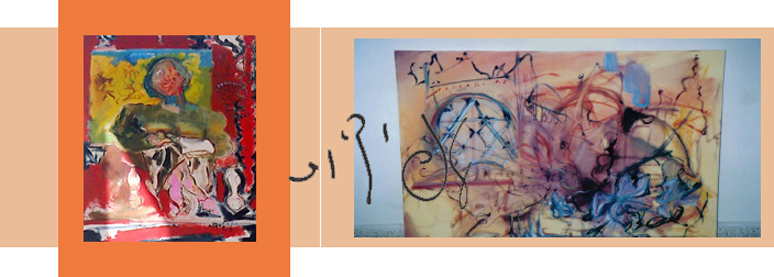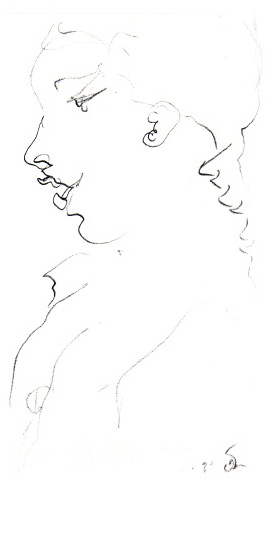


| - | The Relationship of the Artist to Society This paper is about the artist's overwhelming faith in himself and in his art in the face of demoralization, poverty, illness and any other obstacles including parenthood, that come his way in direct opposition to his powerful self-determination, discipline and love of his work. It is offered here in its original form, the first draft at the artist's typewriter in order to draw you into the creative writing process. The final version is titled "el nexo entre el artista y la sociedad". |
|
| - |
The artist enumerates twenty-four steps in his early morning painting routine. |
|
| - |
"Compose" is a short poem suggesting that composition is not lay-out but rather, inner composure. |
|
| - |
"I Made It Up" is a story illustrating how architecture can be used to direct human behavior. Alienation is recognized as a problem of the modern world by the Modern architect. His successful aesthetic of opening space confronted the human attribute of commiseration. |
|
| - |
This paper was intended to be the proposal for the pre-doctorate thesis. It approaches Jerusalem from a bird's eye view, from G-d in heaven's visual perspective. Jerusalem's beauty is an installation of unity. Historic city-planning maps are included. |
|
| - |
"Paisaje", Spanish for the word landscape and "first draft of Landscape Paper" and "another draft of Landscape Paper in English-Mensajes" and "Landscape in European Art"(augmented draft in English) are stages of one paper. The artist has presented her thinking process, something that cannot be shown in a painting. The paper is about the historic development of landscape, scenes, countryside, as a formal accepted painting genre |
|
| - | Treatise on How to Paint in Oils There were many articles during the renaissance written about the handling of oil and pigment. It was a new medium. These articles were called treatises. In this genre, I have written something that is not about how to use paint but how to use your heart and soul when painting. |
|
| - |
Cezanne said that he sketched in order to improve his height of observation of nature. Rodin said: "Anyone who works from nature knows that it has a super-consciousness of its own". We, the artists, are nor aloof, controlling and above our work. We are involved, submitted and interacting based upon eye, hand and heart, as this poem declares. |
|
| - | ||
| - | ||
| - | Estampa impresa i repertoris iconografics a la pintura espanyola dels s.XV1 i XV11 We were assigned in the doctorate program to compare about five intaglio prints from the royal collection in Madrid to seventeenth century Spanish oil paintings, using one theme. I chose the annunciation, the announcement by the angel to the new Mother. The paper was well received by the department. |
|
| - | Counter Classicism (original draft in English) "Counter Classicism" and "el anti-clasicismo como vehiculo a la expression spiritual" (presented copy in Spanish) are the same paper, one in English and the second translated into Spanish. The Spanish renaissance or the golden age of Spanish art, unlike the Italian or Northern renaissance was not immersed in Greco-Roman idolatry. It was a means of spiritual expression. My paper touches upon the point that the history of art texts in English, French and German neither accurately nor adequately embrace the history of art in Spain due to national bias. |
|
| - | el anti-clasicismo como vehiculo a la expresion espiritual (presented copy in Spanish) |
|
| - | ||
| - |
This is a free style, non-academic written appreciation of Giotto, the Florentine painter of the early fourteenth century. Florence had sent an army to Mallorca to help the Mallorquins defend themselves against the invading Moors. This connection between the two cultures plus the fact that Giotto had spent five years at the Spanish court of Naples where Queen Sancia, who was born in Mallorca, reigned, led me to deduce that Spain had influenced Italian art more than is presented in the French, ,German and English art history books, an idea further developed from an earlier paper on counter-classicism. |
|
| - | Introducción memoria de la investigación "Introduccion memoria de la investigacion" and "Introduction to the Memoria" (in English) highlight the Jerusalem paper. The notes at the end should be constantly referred to as they are numbered throughout the text. They verify and elaborate specific points related to each fact |
|
| - | ||
| - |
Gela Seksztein or Gela Seksztajn the Polish Jewish artist who was incarcerated in the Warsaw ghetto where she continued to paint, is here remembered. Includes Spanish and Mallorquin translations. |
|
| - | el nexo entre el artista y la sociedad (final copy in Spanish) |
|